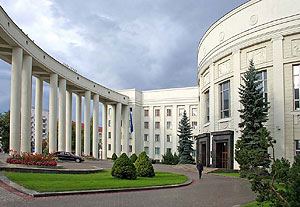Ru
|
Eng
Great potential for cooperation between NASB, American scientists
01.09.2014

The National Academy of Sciences of Belarus sees a great potential for cooperation with American scientists, BelTA learned from NASB Chairman of the Presidium Vladimir Gusakov on 1 September.
A delegation of the National Academies of the United States of America is in Belarus on 30 August – 7 September upon the NASB’s invitation. The delegation is led by Glenn Schweitzer, Director of the Office for Central Europe and Eurasia.
Vladimir Gusakov remarked that the Belarusian side had put forth the initiative to hold negotiations and determine prospects of future cooperation between the academies of the two countries. “We believe we have a good potential. We can establish quality long-term cooperation in a number of areas relating to biological sciences, biotechnologies, chemical sciences, information sciences, math sciences, physics, humanitarian sciences,” said the Chairman of the Presidium of the National Academy of Sciences of Belarus.
In his words, the current American delegation can be classified as a fact-finding one. “If positive information about our academy of sciences is available and the information is already shaping to be rather positive, the next visit may be at the level of the presidents of the national academies of the USA,” stated Vladimir Gusakov.
In turn, Glenn Schweitzer, Director of the Office for Central Europe and Eurasia of the National Academies of the USA, remarked that cooperation between Belarusian and American sciences can and should be promoted. Asked about the most promising scientific areas for cooperation, the scientist mentioned that Belarus boasts prominent researches into laser physics.
“It will be possible to talk about concrete avenues of possible cooperation only after all the institutions on the itinerary are visited. My task is to find these avenues and deliver information about them,” stressed Glenn Schweitzer.
Apart from visiting organizations of the National Academy of Sciences of Belarus the American delegation is supposed to visit the Belarusian branch of the Russian-Belarusian information center for Chernobyl catastrophe consequences of the Radiology Institute, the children’s rehabilitation and recreation center Zhdanovichi, the national research and practice center for transplantation, the Belarusian State Museum of Folk Architecture and Everyday Life in the village of Ozertso, Minsk District.
A delegation of the National Academies of the United States of America is in Belarus on 30 August – 7 September upon the NASB’s invitation. The delegation is led by Glenn Schweitzer, Director of the Office for Central Europe and Eurasia.
Vladimir Gusakov remarked that the Belarusian side had put forth the initiative to hold negotiations and determine prospects of future cooperation between the academies of the two countries. “We believe we have a good potential. We can establish quality long-term cooperation in a number of areas relating to biological sciences, biotechnologies, chemical sciences, information sciences, math sciences, physics, humanitarian sciences,” said the Chairman of the Presidium of the National Academy of Sciences of Belarus.
In his words, the current American delegation can be classified as a fact-finding one. “If positive information about our academy of sciences is available and the information is already shaping to be rather positive, the next visit may be at the level of the presidents of the national academies of the USA,” stated Vladimir Gusakov.
In turn, Glenn Schweitzer, Director of the Office for Central Europe and Eurasia of the National Academies of the USA, remarked that cooperation between Belarusian and American sciences can and should be promoted. Asked about the most promising scientific areas for cooperation, the scientist mentioned that Belarus boasts prominent researches into laser physics.
“It will be possible to talk about concrete avenues of possible cooperation only after all the institutions on the itinerary are visited. My task is to find these avenues and deliver information about them,” stressed Glenn Schweitzer.
Apart from visiting organizations of the National Academy of Sciences of Belarus the American delegation is supposed to visit the Belarusian branch of the Russian-Belarusian information center for Chernobyl catastrophe consequences of the Radiology Institute, the children’s rehabilitation and recreation center Zhdanovichi, the national research and practice center for transplantation, the Belarusian State Museum of Folk Architecture and Everyday Life in the village of Ozertso, Minsk District.
SCIENCE. TECHNOLOGY. INNOVATIONS
13.08.2024
28.06.2024
28.06.2024
25.06.2024
05.06.2024
15.05.2024
15.05.2024
26.04.2024
26.04.2024
26.04.2024













